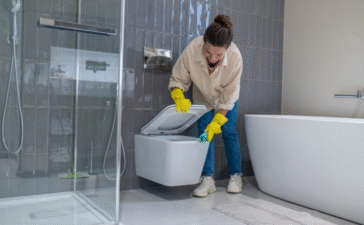Few things are more annoying than a cloud of tiny flies buzzing around your kitchen. One minute you’re enjoying a piece of fruit, and the next, you’re swatting at a swarm of gnats that seem to have appeared out of nowhere. These pests are not only a nuisance but can also be a sign of underlying hygiene issues. Keeping your kitchen gnat-free is essential for your comfort and for maintaining a clean food preparation space. Dealing with a gnat infestation can feel like a losing battle, but it doesn’t have to be. With a combination of expert-backed advice and proven methods, you can effectively eliminate these unwelcome guests and prevent them from returning. This guide will walk you through everything you need to know, from identifying the types of gnats in your home to how to get rid of gnats in kitchen.
What Are Gnats and Why Do They Appear in the Kitchen?
Before you can tackle the problem, it helps to understand what you’re up against. The term “gnat” is often used to describe several types of small, flying insects that are drawn to household environments, particularly kitchens. Identifying the specific type of gnat can help you target their source more effectively.
Understanding Gnats: Types Commonly Found in Kitchens
Most of the tiny flies you find in your kitchen are likely one of three common types: fruit flies, drain flies, or fungus gnats. Fruit flies, scientifically known as Drosophila melanogaster, are perhaps the most common. They have a tan or brownish body with red eyes and are attracted to ripening or fermenting produce. They can lay up to 500 eggs on the surface of overripe fruit, leading to a rapid infestation.
Drain flies, also called moth flies or sewer flies, have a fuzzy, moth-like appearance with dark, hairy bodies and wings. You’ll typically find them near sinks, drains, and garbage disposals, where they breed in the organic sludge that accumulates in pipes.
Fungus gnats are small, dark-bodied insects that look similar to tiny mosquitoes. While they are more common in households with lots of indoor plants, they can also infest kitchens. They thrive in damp soil and feed on fungi and organic matter, so overwatered houseplants or moisture-prone areas can be a breeding ground.
Common Kitchen Attractants for Gnats
Gnats appear in your kitchen because it provides everything they need to survive and reproduce: food, moisture, and breeding sites. Overripe fruits and vegetables left on the counter are a primary attractant for fruit flies. Food spills, crumbs, and sugary residues also provide a ready food source. Drains and garbage disposals create the perfect damp, organic-rich environment for drain flies to lay their eggs. Even a damp sponge or mop can become a breeding site for these persistent pests.
How to Prevent Gnats in the Kitchen: Simple Tips and Habits
Prevention is the most effective strategy for managing a gnat problem. By making your kitchen less hospitable to them, you can stop an infestation before it starts. This involves adopting a few simple but consistent cleaning habits.
Cleanliness is Key: How Regular Cleaning Helps Keep Gnats Away
A clean kitchen is a gnat-free kitchen. Make it a daily habit to wipe down countertops, tables, and other surfaces to remove any food spills or sticky residues. Don’t let food scraps sit out; dispose of them promptly in a sealed trash can. It’s also crucial to clean your sink drains regularly. Pouring hot water down the drain can help flush out some of the organic buildup where drain flies breed.
Proper Food Storage: Preventing Attraction
How you store your food plays a significant role in preventing gnat infestations. Store fruits and vegetables in the refrigerator instead of leaving them on the counter. If you must keep produce out, use a fruit bowl with a cover. Ensure your trash and compost bins have tightly sealed lids and empty them frequently, especially if they contain food waste. Rinsing out jars, cans, and bottles before recycling can also remove sugary remnants that attract gnats.
How to Fix Leaky Faucets and Other Moisture Issues
Gnats are drawn to moisture, so eliminating excess water sources is crucial. Inspect your kitchen for any leaky faucets, pipes, or appliances and repair them promptly. A study published in the Journal of Economic Entomology highlighted that eliminating damp environments is a critical step in controlling indoor fly populations. Ensure your dish sponges and rags are wrung out and allowed to dry completely between uses. Avoid overwatering houseplants and ensure their pots have good drainage.
Effective Natural Methods how to get rid of gnats in kitchen
If you already have a gnat problem, several effective and non-toxic methods can help you eliminate them. These natural solutions use common household items to trap and repel gnats without introducing harsh chemicals into your kitchen.
Apple Cider Vinegar Trap: How to Use It to Attract and Trap Gnats
An apple cider vinegar trap is a classic, highly effective DIY solution for capturing fruit flies. The fermented scent of the vinegar is irresistible to them. To make one, pour about an inch of apple cider vinegar into a jar or small bowl. Add a few drops of dish soap, which will break the surface tension of the vinegar and cause the gnats to sink and drown. You can cover the jar with plastic wrap and poke a few small holes in it to allow the gnats to enter but make it difficult for them to escape. Place these traps near problem areas, like your fruit bowl or sink.
Essential Oils: Natural Repellents for Gnats
Certain essential oils act as natural insect repellents. Lemongrass, eucalyptus, peppermint, and lavender are known to be effective against gnats. You can create a DIY repellent spray by adding 10-15 drops of your chosen essential oil to a spray bottle filled with water. A few drops of dish soap can help the oil and water mix. Lightly mist this solution around your kitchen, focusing on windows, doorways, and near trash cans. You can also use an essential oil diffuser to spread the scent throughout the room.
Baking Soda and Vinegar Solution for Drains
To tackle drain flies at their source, you need to clean the organic buildup inside your pipes. A simple baking soda and vinegar solution can do the trick. Pour about half a cup of baking soda down the drain, followed by half a cup of white vinegar. The mixture will fizz and help break down the grime. Let it sit for at least an hour, or even overnight, before flushing the drain with hot water. This method helps eliminate the breeding grounds for drain flies.
Chemical Solutions and Store-Bought Products to Combat Gnats
For more severe infestations, you might need to turn to chemical solutions or commercially available products. These can offer a quick and powerful way to reduce the gnat population, but it’s important to use them safely.
Gnat Traps: How to Choose the Right One for Your Kitchen
There are many types of gnat traps available for purchase. Sticky traps are a simple and effective option; these are strips of paper coated with a sticky substance that captures gnats upon contact. You can hang them near windows or place them in plant pots. Electric insect zappers use ultraviolet light to attract gnats and then electrocute them. These can be effective but may not be ideal for a quiet kitchen environment. There are also discreet, decorative traps that use a lure and a sticky surface, blending in better with your kitchen decor.
Chemical Sprays: When to Use Them and Safety Considerations
Insecticide sprays designed for flying insects can quickly kill gnats on contact. However, you must be cautious when using them in the kitchen. Always choose a product that is labeled as safe for use in food preparation areas. Follow the manufacturer’s instructions carefully, ensuring proper ventilation and removing or covering all food, utensils, and countertops before spraying. It is generally best to use sprays as a last resort and to focus on prevention and trapping methods first.
Also Read this article: “moth treatment for rugs“
Preventing Future Gnat Infestations: Long-Term Strategies
Once you’ve eliminated the current gnat population, the final step is to implement long-term strategies to ensure they don’t come back. A proactive approach is the key to a permanently gnat-free kitchen.
Sealing Cracks and Gaps: Preventing Entry Points for Gnats
Gnats can enter your home through tiny cracks and gaps around windows, doors, and foundations. Inspect your kitchen for any potential entry points and seal them with caulk or weather stripping. This simple step can make a big difference in keeping pests out.
Installing Window Screens and Using Fans
Proper window screens are your first line of defense against flying insects. Ensure all your windows have well-fitting screens that are free of holes or tears. Good air circulation can also deter gnats, as they are weak fliers. Using a fan in your kitchen can create a breeze that makes it difficult for them to fly and land.
Routine Maintenance: Why It’s Important to Keep Your Kitchen Gnat-Free
Consistency is crucial. Establish a regular cleaning and maintenance routine for your kitchen. This should include daily wipe-downs, frequent trash removal, and weekly drain cleaning. By consistently eliminating food and moisture sources, you make your kitchen an unattractive place for gnats to live and breed.
Take Back Your Kitchen Today
Dealing with gnats is undoubtedly frustrating, but it is a solvable problem. By combining preventative cleaning habits with effective trapping and elimination methods, you can successfully rid your kitchen of these pests. A clean, dry, and well-maintained kitchen is your best defense. Start implementing these strategies today to create a more hygienic and comfortable space for you and your family to enjoy.
FAQs
Are gnats harmful in the kitchen?
While gnats are generally considered a nuisance rather than a serious health hazard, they can pose some risks. Fruit flies and drain flies can transfer bacteria from unsanitary surfaces (like drains or rotting food) to clean areas, including your food and countertops. This can potentially lead to foodborne illnesses. For this reason, it’s important to eliminate them to maintain kitchen hygiene.
How long does it take to get rid of gnats in the kitchen?
The time it takes to get rid of gnats depends on the severity of the infestation and the methods you use. If you act quickly and remove their food and breeding sources, you can see a significant reduction in the gnat population within a few days. However, since the gnat life cycle can last a few weeks, it may take 2-3 weeks of consistent effort to completely eliminate them and their eggs.
Can I use store-bought gnat traps around pets and children?
Safety is a primary concern when using any pest control product. Many sticky traps are non-toxic and generally safe, but they should be placed out of reach of curious children and pets to avoid a sticky mess. If you opt for chemical sprays or baits, read the product label carefully. Look for products that are specifically labeled as safe for use around pets and children, and always follow the usage instructions to minimize any risk.












